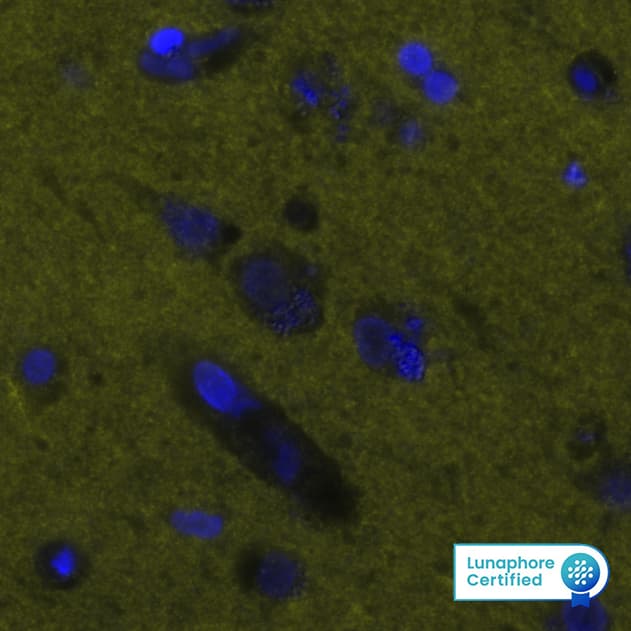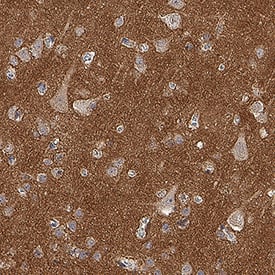Human NCAM-1/CD56 Antibody Summary
Leu20-Pro603 and Glu636-Asn741
Accession # NP_001070150
*Small pack size (-SP) is supplied either lyophilized or as a 0.2 µm filtered solution in PBS.
Applications
Please Note: Optimal dilutions should be determined by each laboratory for each application. General Protocols are available in the Technical Information section on our website.
Scientific Data
 View Larger
View Larger
Detection of NCAM-1/CD56 in Human Brain Cortex via seqIF™ staining on COMET™ NCAM-1/CD56 was detected in immersion fixed paraffin-embedded sections of human brain Cortex using Mouse Anti-Human NCAM-1/CD56, Monoclonal Antibody (Catalog # MAB24081) at 25ug/mL at 37° Celsius for 8 minutes. Before incubation with the primary antibody, tissue underwent an all-in-one dewaxing and antigen retrieval preprocessing using PreTreatment Module (PT Module) and Dewax and HIER Buffer H (pH 9; Epredia Catalog # TA-999-DHBH). Tissue was stained using the Alexa Fluor™ 647 Goat anti-Mouse IgG Secondary Antibody at 1:200 at 37 ° Celsius for 2 minutes. (Yellow; Lunaphore Catalog # DR647MS) and counterstained with DAPI (blue; Lunaphore Catalog # DR100). Specific staining was localized to the neuropil. Protocol available in COMET™ Panel Builder.
 View Larger
View Larger
Detection of Human NCAM‑1/CD56 by Western Blot. Western blot shows lysates of human brain (cerebellum and hypothalamus). PVDF membrane was probed with 2 µg/mL of Mouse Anti-Human NCAM‑1/CD56 Monoclonal Antibody (Catalog # MAB24081) followed by HRP-conjugated Anti-Mouse IgG Secondary Antibody (HAF018). A specific band was detected for NCAM‑1/CD56 at approximately 105-130 kDa (as indicated). This experiment was conducted under reducing conditions and using Western Blot Buffer Group 1.
 View Larger
View Larger
Detection of NCAM-1/CD56 in Human PBMC by Flow Cytometry. Human PBMCs were stained with either (A) Mouse Anti-Human NCAM-1/CD56 Monoclonal Antibody (Catalog # MAB24081) or (B) Mouse IgG2B Isotype Control (MAB0041) followed by Anti-Mouse IgG APC-conjugated secondary antibody (F0101B) and Mouse Anti-Human NKp46 PE-conjugated Monoclonal Antibody (FAB1850P). Staining was performed using our Staining Membrane-associated Proteins protocol.
 View Larger
View Larger
Detection of NCAM-1/CD56 in Human NK cells by Flow Cytometry. Human NK cells were expanded from PBMCs using Cloudz Human NK Cell Expansion Kit (CLD004) and were stained with either (A) Mouse Anti-Human NCAM-1/CD56 Monoclonal Antibody (Catalog # MAB24081) or (B) Mouse IgG2B Isotype Control (MAB0041) followed by Anti-Mouse IgG APC-conjugated secondary antibody (F0101B) and Mouse Anti-HumanCD3 PE-conjugated Monoclonal Antibody (FAB100P). Staining was performed using our Staining Membrane-associated Proteins protocol.
 View Larger
View Larger
Detection of NCAM‑1/CD56 in Human Brain Cortex. NCAM‑1/CD56 was detected in immersion fixed paraffin-embedded sections of human brain cortex using Mouse Anti-Human NCAM‑1/CD56 Monoclonal Antibody (Catalog # MAB24081) at 25 µg/ml for 1 hour at room temperature followed by incubation with the Anti-Mouse IgG VisUCyte™ HRP Polymer Antibody (Catalog # VC001) or the HRP-conjugated Anti-Mouse IgG Secondary Antibody (Catalog # HAF007). Before incubation with the primary antibody, tissue was subjected to heat-induced epitope retrieval using VisUCyte Antigen Retrieval Reagent-Basic (Catalog # VCTS021). Tissue was stained using DAB (brown) and counterstained with hematoxylin (blue). Specific staining was localized to the neuropil. View our protocol for IHC Staining with VisUCyte HRP Polymer Detection Reagents.
Reconstitution Calculator
Preparation and Storage
- 12 months from date of receipt, -20 to -70 °C as supplied.
- 1 month, 2 to 8 °C under sterile conditions after reconstitution.
- 6 months, -20 to -70 °C under sterile conditions after reconstitution.
Background: NCAM-1/CD56
Neural cell adhesion molecule 1 (NCAM-1) is a multifunctional member of the Ig superfamily. It belongs to a family of membrane-bound glycoproteins that are involved in Ca++ independent cell matrix and homophilic or heterophilic cell-cell interactions. NCAM-1 specifically binds to heparan sulfate proteoglycans (1), the extracellular matrix protein agrin (2), and several chondroitin sulfate proteoglycans that include neurocan and phosphocan (3). There are three main forms of human NCAM-1 that arise by alternate splicing. These are designated NCAM-120/NCAM-1 (761 amino acids [aa]), NCAM-140 (848 aa), and NCAM-180 (1120 aa). NCAM-120 is GPI-linked, while NCAM-140 and NCAM-180 are type I transmembrane glycoproteins (4‑6). Additional alternate splicing adds considerable diversity to all three forms, and extracellular proteolytic processing is possible for NCAM-180 (7‑8). NCAM-1 is synthesized as a 761 aa preproprecursor that contains a 19 aa signal sequence, a 722 aa GPI-linked mature region, and a 20 aa C-terminal prosegment (4). The molecule contains five C-2 type Ig-like domains and two fibronectin type-III domains. Human to mouse, NCAM-1 is 93% aa identical. NCAM-1 appears to be highly sialylated. The polysialyation of NCAM-1 reduces its adhesive property and increases its neurite outgrowth promoting features (9). NCAM-1 in the adult brain shows a decline of sialylation relative to earlier developmental periods. In regions that retain a high degree of neuronal plasticity, however, the adult brain continues to express polysialylation-NCAM-1, suggesting sialylation of NCAM-1 is involved in regenerative processes and synaptic plasticity (10‑13).
- Burg, M.A. et al. (1995) J. Neurosci. Res. 41:49.
- Storms, S.D. and U. Rutishauser (1998) J Biol. Chem. 273:27124.
- Margolis, R.K. et al. (1996) Perspect. Dev. Neurobiol. 3:273.
- Dickson, G. et al. (1987) Cell 50:1119.
- Lanier, L.L. et al. (1991) J. Immunol. 146:4421.
- Hemperly, J.J. et al. (1990) J. Mol. Neurosci. 2:71.
- Rutishauser, U.and C. Goridis (1986) Trends Genet. 2:72.
- Vawter, M.P. et al. (2001) Exp. Neurol. 172:29.
- Rutihauser, U. (1990) Adv. Exp. Med. Biol. 265:179.
- Becker, C.G. et al. (1996) J. Neurosci. Res. 45:143.
- Doherty, P. et al. (1995) J. Neurobiol. 26:437.
- Eckardt, M. et al. (2000) J. Neurosci. 20:5234.
- Muller, D. et al. (1996) Neuron 17:413.
Product Datasheets
Citations for Human NCAM-1/CD56 Antibody
R&D Systems personnel manually curate a database that contains references using R&D Systems products. The data collected includes not only links to publications in PubMed, but also provides information about sample types, species, and experimental conditions.
11
Citations: Showing 1 - 10
Filter your results:
Filter by:
-
3D map of the human corneal endothelial cell
Authors: Zhiguo He, Fabien Forest, Philippe Gain, Damien Rageade, Aurélien Bernard, Sophie Acquart et al.
Scientific Reports
-
Interaction between HLA-G and NK cell receptor KIR2DL4 orchestrates HER2-positive breast cancer resistance to trastuzumab
Authors: Guoxu Zheng, Zhangyan Guo, Weimiao Li, Wenjin Xi, Baile Zuo, Rui Zhang et al.
Signal Transduction and Targeted Therapy
-
Investigating the role of molecular coating in human corneal endothelial cell primary culture using artificial intelligence-driven image analysis
Authors: Travers, G;Coulomb, L;Aouimeur, I;He, Z;Bonnet, G;Ollier, E;Gavet, Y;Moisan, A;Gain, P;Thuret, G;Maurin, C;
Scientific reports
Species: Human
Sample Types: Whole Cells
Applications: Immunocytochemistry -
Investigating the Role of TGF-? Signaling Pathways in Human Corneal Endothelial Cell Primary Culture
Authors: Aouimeur, I;Sagnial, T;Coulomb, L;Maurin, C;Thomas, J;Forestier, P;Ninotta, S;Perrache, C;Forest, F;Gain, P;Thuret, G;He, Z;
Cells
Species: Human
Sample Types: Whole Cells
Applications: ICC -
Induction of Corneal Endothelial-like Cells from Mesenchymal Stem Cells of the Umbilical Cord
Authors: Eun Ah Ye, Ho Seok Chung, Yoonkyung Park, Jeong Hye Sunwoo, Whanseo Lee, Jin Kim et al.
International Journal of Molecular Sciences
Species: Human
Sample Types: Whole Cells
Applications: Immunocytochemistry -
Diminished expression of major histocompatibility complex facilitates the use of human induced pluripotent stem cells in monkey
Authors: X Wang, M Lu, X Tian, Y Ren, Y Li, M Xiang, S Chen
Stem Cell Res Ther, 2020-08-03;11(1):334.
Species: Human
Sample Types: Protein
-
Radiotherapy and chemotherapy change vessel tree geometry and metastatic spread in a small cell lung cancer xenograft mouse tumor model
Authors: T Frenzel, B Hoffmann, R Schmitz, A Bethge, U Schumacher, G Wedemann
PLoS ONE, 2017-11-06;12(11):e0187144.
Species: Mouse
Sample Types: Whole Tissue
Applications: IHC-P -
Selectins mediate small cell lung cancer systemic metastasis.
Authors: Heidemann F, Schildt A, Schmid K, Bruns O, Riecken K, Jung C, Ittrich H, Wicklein D, Reimer R, Fehse B, Heeren J, Luers G, Schumacher U, Heine M
PLoS ONE, 2014-04-03;9(4):e92327.
Species: Human
Sample Types: Cell Culture Supernates
Applications: Flow Cytometry -
Satellite cells senescence in limb muscle of severe patients with COPD.
Authors: Theriault ME, Pare MÈ, Maltais F, Debigare R
PLoS ONE, 2012-06-13;7(6):e39124.
Species: Human
Sample Types: Whole Tissue
Applications: IHC-Fr -
Induction of Corneal Endothelial-like Cells from Mesenchymal Stem Cells of the Umbilical Cord
Authors: Eun Ah Ye, Ho Seok Chung, Yoonkyung Park, Jeong Hye Sunwoo, Whanseo Lee, Jin Kim et al.
International Journal of Molecular Sciences
-
A New Patient-Derived Metastatic Glioblastoma Cell Line: Characterisation and Response to Sodium Selenite Anticancer Agent
Authors: Sylvie Berthier, Louis Larrouquère, Pierre Champelovier, Edwige Col, Christine Lefebvre, Cécile Cottet-Rouselle et al.
Cancers (Basel)
FAQs
No product specific FAQs exist for this product, however you may
View all Antibody FAQsReviews for Human NCAM-1/CD56 Antibody
There are currently no reviews for this product. Be the first to review Human NCAM-1/CD56 Antibody and earn rewards!
Have you used Human NCAM-1/CD56 Antibody?
Submit a review and receive an Amazon gift card.
$25/€18/£15/$25CAN/¥75 Yuan/¥2500 Yen for a review with an image
$10/€7/£6/$10 CAD/¥70 Yuan/¥1110 Yen for a review without an image






